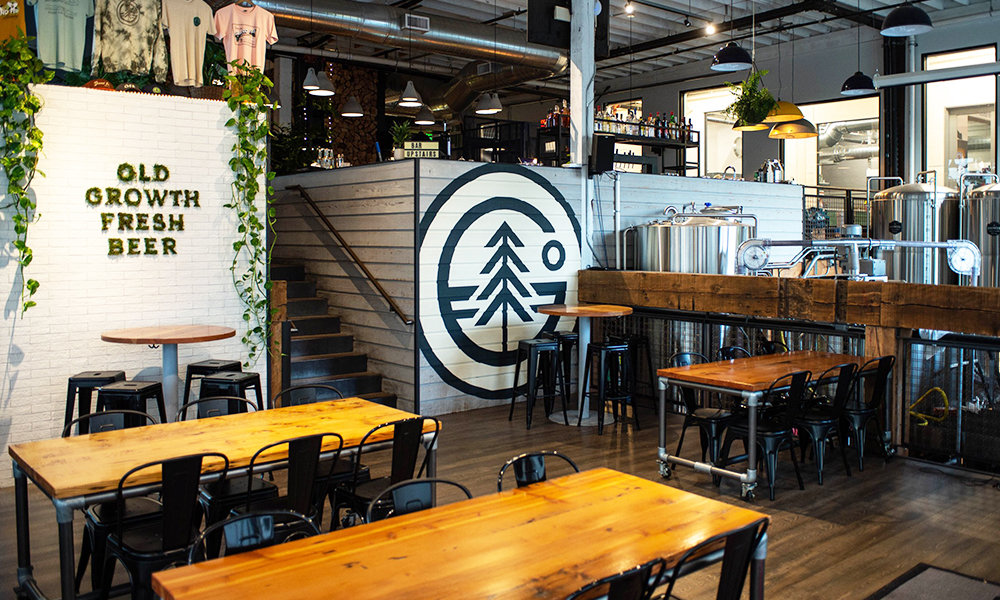Last year, Cheyne and Erika Tessier, the married owners of Origin Beer Project, took over the closed Beer on Earth taproom in Providence, Rhode Island. The space had solid bones, with a built-out bar and draught system, but the hand-me-down seating could make a chiropractor cringe.
“Any available spot was a stool,” Cheyne says of the array of butt-numbing, backless metal seats.
“I’d rather stand than sit in one for an extended period of time,” Erika says.
When the previous taproom tenant asked to sell the stools, “we were like, ‘Abso-[bleep-ing]-lutely. Sell them and get them out of here,’” Erika says. She instead bought faux-rattan arm chairs, her attempt to break the “strange chokehold” that the metal chairs and stools hold on the industry.
If you’ve visited a bar, restaurant, or taproom in the 21st century, there’s a near-certainty that you’ve sat in some version of The Chair. The metal industrial seating comes in a rainbow of colors, with holes in the seat and cross beams to awkwardly rest feet. The back, if there is one, barely bests a bed of nails for comfort.
“They’re too tiny for regular human heinies and aggressively uncomfortable, as if they’re daring you to actually sit on them,” says Niko Tonks, head brewer of Little Thistle Brewing in Rochester, Minnesota.
The Chair has become the shaker pint of taproom furniture: ubiquitous, affordable, stackable, easy to clean, and largely unloved. No one is excited to sit in The Chair. But there is rarely an option, like a taproom with all IPAs on tap. The Chair keeps proliferating, too. In an average year, restaurant supply company WebstaurantStore.com will sell around 10,000 versions of The Chair from Lancaster Table & Seating. How did such polarizing seating rear up at taprooms?
Nearly Century-Old European Lineage
Every object has an origin. In 1927, designer Xavier Pauchard founded the French manufacturing company Tolix, using galvanized steel—it’s dipped in molten zinc to thwart corrosion and rust—to create outdoor furniture. The company designed the first version of the Chaise A in 1934, and in time it became staple seating at French cafés and bistros, the chair’s seat holes permitting easy drainage on rainy days. (In 1956, the company released a more stackable version that endures today.)
Today, a single Tolix Chaise A costs more than $500. Knockoff stools and chairs might cost around $30 to $35 each or cheaper when bought in bulk. For cash-strapped breweries and beverage companies getting off the ground, the price is right to outfit a spacious taproom.
Mark Oberle, owner and mead maker at Meadiocrity Mead in San Marcos, California, outfitted his taproom with upward of 60 chairs. Low cost trumped lumbar support. “I’d love to have more custom comfortable chairs, but when you’re buying that many items, the price adds up,” he says.
As Jeff Smith worked to open LUKI Brewery in Arvada, Colorado, costs for brewing infrastructure, draught system, and taproom buildout kept increasing, decreasing the available cash for tables and seating. After the construction dust cleared, “we just wanted to get open and start serving beer—for as cheap as possible,” Smith says. “We jumped on WebstaurantStore.com, searched ‘stools,’ and our eyes went to the cheapest one, which is our friend the metal stool.”
Brewing and drinking beer can be messy business, and taproom floors are sticky expanses of spilled beer. The ability to stack and move the lightweight seating is another compelling sales pitch as “you’re going to be mopping the floors,” says Kyle Kensrue, account executive, brewery solutions, for Next Glass and former director of operations at Randolph Beer in New York City.
Like kegs, the seating “just kind of gets thrown around. They’re just going to get trashed over time because hopefully your taproom is busy enough.”
Industrial Look. Taproom Design
Drinking fresh IPAs served in an industrial-park taproom can still feel like the pinnacle of beer consumption. The sleek and stark Tolix-style seating harkens back to the mid-20th century and looks terrific in taprooms set-dressed in brick walls, Edison light bulbs, and exposed piping.
“I like vintage-looking things, and to me the stool looks like it could have been in my great-grandfather’s workshop,” says Dan Endicott, owner of Forest & Main Brewing in Ambler, Pennsylvania.

Forest & Main has two locations in Ambler, both with different seating requirements. The British-inspired Pub is a cozy room to drink cask ale while sitting in mismatched chairs bought from thrift and antique shops, or gifted from customers. “They’re awesome, but they also break all the time and have to be glued back quite often,” Endicott says. “And we’re always worried about someone hurting themselves.”
The fear is well-founded. One of the brewery’s wooden stools broke, and the brewery was nearly taken to court over the incident. Forest & Main’s sleeker Ambler taproom, which opened in late 2022, features Tolix-style stools in an eye-catching green that echoes a saison bottle. “They’re the best-looking stools that you can find online that are structurally sound and not completely hideous,” Endicott says.
A taproom’s purpose is to sell as many beverages as possible, and more accommodating seating might boost sales. The core craft beer demographic is aging, “and people want to be comfortable in a nice environment,” says Andrew Said Thomas, founder of Halftone Spirits, a Brooklyn distillery that shares a taproom with Finback Brewery. The main space is outfitted with a variety of backed chairs from minimalist furniture company Article. “You want butts in seats for as long as possible.”
While working at a beer bar in Portland, Oregon, Richard LaRue regularly fielded complaints about The Chair. “People were like, ‘How am I supposed to have more than two beers and sit in this chair?’” says LaRue, now the general manager at Recluse Brew Works in Washougal, Washington. The brewery opened in December with cushioned chairs and stools that encourage lingering while playing games and sipping pints of German-style Pilsners. “Being comfortable is an important part of that,” LaRue says.
Taproom seating can also deliver whimsy and delight, such as the swivel stools used at New Realm Brewing’s Auburn, Alabama, location. “I can’t believe how often people comment on how nice it is to spin on our stools,” says Drew Kostic, head brewer and general manager. Taproom guests are often reminded of old-school McDonald’s stools. “There is an innate level of childhood comfort that comes with being able to spin on a stool.”
The Chair isn’t going anywhere. The maligned furniture is, for better or worse, permanently entrenched in America’s taproom firmament, destined to be passed down to successive generations of breweries. The married duo of brewer Whitney Burnside and chef Doug Adams opened Grand Fir Brewing in the former West Coast Grocery space in Portland, Oregon, inheriting plenty of the notorious chairs and stools.

“We didn’t have the money to buy new chairs, so that’s what we’re stuck with,” Adams says.
The Chair might break your back, but seating alone won’t break a brewery’s business.
CraftBeer.com is fully dedicated to small and independent U.S. breweries. We are published by the Brewers Association, the not-for-profit trade group dedicated to promoting and protecting America’s small and independent craft brewers. Stories and opinions shared on CraftBeer.com do not imply endorsement by or positions taken by the Brewers Association or its members.


Share Post